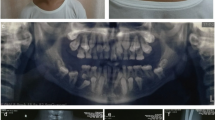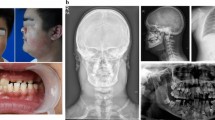Abstract
Aim: To investigate the phenotypical expression of an identical mutation of the CBFA1/RUNX2 gene within a family with cleidocranial dysplasia.
Patients and Method: A five-member family underwent clinical examination.Two members, father and son, showed dissimilar symptoms of cleidocranial dysplasia. The two affected patients were examined for syndrome-typical symptoms, and the genotype was determined by molecular-genetic analysis.
Results: In both patients an identical missense mutation (G146R) in exon 2 of the CBFA1/RUNX2 gene was identified. In father and son the dental disturbances were similarly clearly expressed. However, the craniofacial skeleton of the son exhibited fewer dysostotic ossification features than that of the father. In the three clinically healthy family-members no mutation of the CBFA1/RUNX2 gene was found.
Conclusion: In two patients with cleidocranial dysplasia an identical missense mutation in the CBFA1/RUNX2 gene leading to a divergent craniofacial phenotype was determined. The results indicate marked variability in the phenotypical expression of CBFA1/RUNX2 mutations.
Zusammenfassung
Ziel: Das Ziel dieser Untersuchung bestand darin, die phänotypische Expression einer identischen Mutation des CBFA1/RUNX2-Gens innerhalb einer Familie mit Dysostosis cleidocranialis zu analysieren.
Patienten und Methode: Eine fünfköpfige Familie mit zwei Betroffenen wurde klinisch untersucht. Zwei Familienmitglieder, Vater und Sohn, wiesen in unterschiedlichem Umfang Symptome der Dysostosis cleidocranialis auf. Die beiden betroffenen Patienten wurden hinsichtlich der syndromtypischen Symptomatik befundet und er Genotyp molekulargenetisch bestimmt.
Ergebnisse: Bei beiden Betroffenen gelang der Nachweis einer Punktmutation (G146R) in Exon 2 des CBFA1/RUNX2-Gens. Bei Vater und Sohn waren die Störung des Zahnsystems gleichermaßen deutlich ausgeprägt. Das kraniofaziale Skelett des Sohnes war jedoch in geringerem Umfang mit dysostostotischen Ossifikationsmerkmalen behaftet als das des Vaters. Bei den drei klinisch unauffälligen, direkt mit dem Vater verwandten Familenmitgliedern konnte keine Mutation des CBFA1/RUNX2-Gens festgestellt werden.
Schlussfolgerung: Bei zwei Patienten mit Dysostosis cleidocranialis konnte eine identische Missensemutation im CBFA1/RUNX2-Gen nachgewiesen werden. Diese führte zu einem unterschiedlichen kraniofazialen Phänotyp. Die Ergebnisse weisen auf eine hohe Variabilität in der phänotypischen Expression von CBFA1/RUNX2-Mutationen hin.
Similar content being viewed by others
Author information
Authors and Affiliations
Additional information
Received: August 23, 2001; accepted: December 20, 2001
Rights and permissions
About this article
Cite this article
Golan, I., Baumert, U., Wagener, H. et al. Evidence of Intrafamilial Variability of CBFA1/RUNX2 Expression in Cleidocranial Dysplasia – a Family Study. Journal of Orofacial Orthopedics / Fortschritte der Kieferorthopädie 63, 190–198 (2002). https://doi.org/10.1007/s00056-002-0123-4
Published:
Issue Date:
DOI: https://doi.org/10.1007/s00056-002-0123-4




